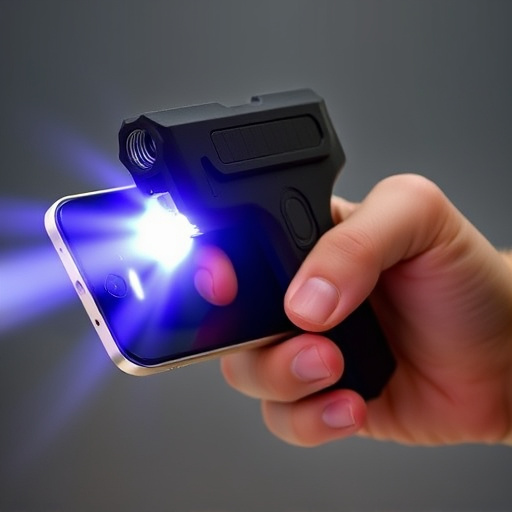The effectiveness and safety of a Smart Phone Stun Gun hinge on managing electrical current flow. Optimized current spread patterns, achieved through strategic electrode placement and precise engineering, are vital for muscle disruption while minimizing risks. Advanced analysis techniques, using data modeling and simulation, enable researchers to study current interaction with materials and living tissues, leading to safer designs. By understanding and controlling current spread in Smart Phone Stun Guns, electrical engineers contribute to responsible non-lethal weapons development and enhance safety across various sectors.
Electrical current spread pattern analysis is a critical aspect of understanding and enhancing the safety and effectiveness of stun guns, including smart phone stun guns. This article delves into the intricate world of electrical behavior, exploring how design choices influence the dissemination of current. We examine advanced analysis techniques that promise improved safety measures. By leveraging data-driven insights, we can optimize device performance, ensuring their reliability in real-world applications.
- Understanding Electrical Current and Its Behavior
- The Impact of Design on Spread Patterns in Stun Guns
- Advanced Analysis Techniques for Improved Safety
- Practical Applications: Using Data to Enhance Device Effectiveness
Understanding Electrical Current and Its Behavior

Electrical current, a fundamental concept in physics and engineering, refers to the flow of charged particles, typically electrons, through a conductor. When applied to practical contexts like the Smart Phone Stun Gun, understanding this flow becomes critical for safety and effectiveness. The behavior of electrical current is not straightforward; it’s influenced by factors such as resistance, voltage, and the physical layout of the circuit.
In the case of a stun gun, the current spreads rapidly through the body of the target, aiming to disrupt muscle control and cause temporary incapacitation. This spread pattern depends on the design of the device—its electrodes, the current’s path within the body, and the duration it stays active. Analyzing this electrical current spread is crucial for optimizing stun gun performance while minimizing risks associated with excessive current flow.
The Impact of Design on Spread Patterns in Stun Guns

The design of a stun gun plays a significant role in determining its electrical current spread pattern, which is crucial for its effectiveness and safety. Modern smart phone stun guns, for instance, incorporate advanced technologies to optimize their design. These devices often feature specialized electrodes that are strategically placed to maximize the delivery of electric current to the target area, ensuring a powerful but controlled stun effect.
The shape, size, and material of the stun gun’s housing can also influence how the electrical current spreads. Conductive materials and smooth surfaces promote efficient current flow, while non-conductive or irregular designs may lead to localized hotspots or uneven distribution. Understanding these design factors is essential for engineers aiming to create more effective and user-friendly stun guns, especially in compact forms like smart phone stun guns, where space optimization needs to be balanced with optimal performance.
Advanced Analysis Techniques for Improved Safety

In the pursuit of enhanced safety measures, especially in scenarios involving potentially dangerous individuals, Advanced Analysis Techniques play a pivotal role. These techniques are particularly useful when examining the spread pattern of electrical current, as is pertinent to understanding the effectiveness and range of a Smart Phone Stun Gun. By employing sophisticated data modeling and simulation tools, researchers can meticulously study how current flows and interacts with various conductive materials and living tissues. This detailed analysis allows for a deeper comprehension of the stun gun’s impact and its safety implications.
Through these advanced methods, professionals can optimize the design and functionality of such devices, ensuring they deliver precise, controlled shocks while minimizing unintended harm to bystanders or users. The insights gained from this research not only improve personal safety but also contribute to the development of more responsible and effective non-lethal weapons technology.
Practical Applications: Using Data to Enhance Device Effectiveness

In the realm of electrical engineering and safety technology, understanding how current spreads is pivotal, especially in devices designed for self-defense like the Smart Phone Stun Gun. By analyzing the spread pattern of electrical current, engineers can optimize device effectiveness and enhance user safety. This data-driven approach allows for precise adjustments to electrode placement, voltage output, and pulse duration, ensuring optimal shock delivery while minimizing potential harm to users or bystanders.
Practical applications extend beyond self-defense gadgets; this analysis is invaluable in improving electrical systems across various sectors. From refining the design of advanced electronics to enhancing safety protocols in industrial settings, the insights gleaned from current spread pattern studies can lead to significant innovations. By leveraging data and staying at the forefront of technological advancements, engineers contribute to safer, more efficient devices that cater to our daily needs, including powerful tools like Smart Phone Stun Guns.
Electrical current spread pattern analysis plays a pivotal role in enhancing the safety and effectiveness of smart phone stun guns. By understanding how current behaves and the impact of design choices, manufacturers can develop more reliable devices. Advanced analysis techniques enable precise control over current distribution, ensuring user safety while maximizing the stun gun’s operational effectiveness. This data-driven approach to design is transforming the industry, making stun guns safer and more efficient tools for personal protection.
